
(Click on any image below for a larger version)
Saturday, January 20: Volunteer Point, Falkland Islands
We cruised very slowly that evening from West Falkland to Volunteer Point on the eastern coast of East Falkland. The beach was exposed to the open ocean, and the Hanseatic usually did not manage to land passengers at Volunteer Point because of the rough conditions. Conditions often deteriorated during the morning, so the landing was scheduled for 7:00 A.M.
The morning was overcast and the wind was blowing 10 miles per hour or more, but the surf conditions were favorable for the Zodiac landing.
A dolphin immediately joined the Zodiac as we turned toward the shore. It broke the surface several times, first on one side of the bow and then on the other, for a good fraction of the ride in to the beach.
There was a bit of a chop, and we bounced across the wave tops. Small waves about 1 foot tall were breaking gently on the beach. The Zodiac driver slowed the boat as we neared the shore. A small breaker rolled over the stern of the Zodiac and splashed through the interior of the boat. The driver spun the Zodiac around to keep the bow pointed at the waves, so we exited over the stern and waded through the surf to the shore.
 A small group of King Penguins was wandering
along the beach with no apparent destination in mind. They were
the largest species of penguin that we saw on our expedition.
They are much more colorful than the other species. They have an
orange spot on each side of their head and an orange bib.
A small group of King Penguins was wandering
along the beach with no apparent destination in mind. They were
the largest species of penguin that we saw on our expedition.
They are much more colorful than the other species. They have an
orange spot on each side of their head and an orange bib.
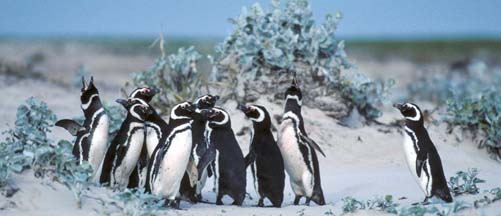 There were numerous Magellanic Penguins
waddling on the beach. Some were headed out to go fishing, while
others were returning with a belly full of fish.
There were numerous Magellanic Penguins
waddling on the beach. Some were headed out to go fishing, while
others were returning with a belly full of fish.
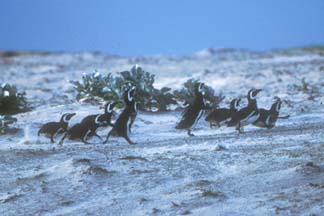 As one group of Magellanic Penguins started to
climb up the dunes, they dropped down and started running forward
on all-fours, using their wings in a windmilling motion as well
as pushing with their feet to keep their bodies a few inches off
the sand.
As one group of Magellanic Penguins started to
climb up the dunes, they dropped down and started running forward
on all-fours, using their wings in a windmilling motion as well
as pushing with their feet to keep their bodies a few inches off
the sand.
A few Gentoo Penguins were scattered around the beach. They could be distinguished from the Magellanic Penguins by their bright orange feet and white head spots. They were far outnumbered on the beach by the Magellanic Penguins.
We hiked over the beach dunes through a Magellanic Penguin rookery. The dunes were riddled with penguin burrows. The fields beyond the dunes were covered in moss and short grass.
Magellanic Penguins languished on their bellies in the grass near the entrances to their burrows, which were scattered across the field. Other penguins were standing on the grass, preening their feathers. Clusters of penguins waddled to and from the dunes. It looked like the golf course of a penguin country club.
 "Have you seen my ball? I think it's in
the sand trap."
"Have you seen my ball? I think it's in
the sand trap."
 We arrived at a King Penguin rookery with several hundred
breeding pairs standing on a large patch of bare earth. Nearby
there were large colonies of Gentoo penguins.
We arrived at a King Penguin rookery with several hundred
breeding pairs standing on a large patch of bare earth. Nearby
there were large colonies of Gentoo penguins.
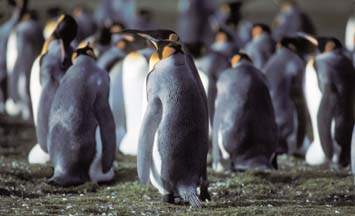 While we were observing the penguins, the sun broke through the
morning clouds and highlighted the brilliant orange head spots of
the King Penguins. The ground was nearly coated with white
penguin feathers.
While we were observing the penguins, the sun broke through the
morning clouds and highlighted the brilliant orange head spots of
the King Penguins. The ground was nearly coated with white
penguin feathers.
 The back feathers of the adult King Penguins are silvery gray,
not as dark black as other penguins.
The back feathers of the adult King Penguins are silvery gray,
not as dark black as other penguins.
King Penguins are described on the Falklands Conservation Penguin Page.
Link to the Penguin Page description of King Penguins .
Once the sun came out, it was reasonably warm. I had to unzip my parka and the jacket I was wearing under it to cool myself off.
 There were a few juvenile King Penguins. Their
backs were blacker, not as silver as the adults' backs. Their
head spots were a pale yellow, rather than the intense orange of
the adult's. They were nearly as tall as the adults and actually
a bit more rotund, with better fat reserves.
There were a few juvenile King Penguins. Their
backs were blacker, not as silver as the adults' backs. Their
head spots were a pale yellow, rather than the intense orange of
the adult's. They were nearly as tall as the adults and actually
a bit more rotund, with better fat reserves.
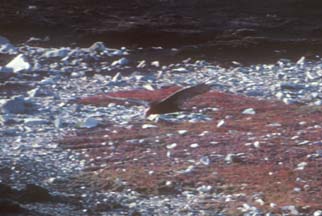 A Turkey Buzzard soared low along the foot of a small rise,
catching the wind rising over the low topography.
A Turkey Buzzard soared low along the foot of a small rise,
catching the wind rising over the low topography.
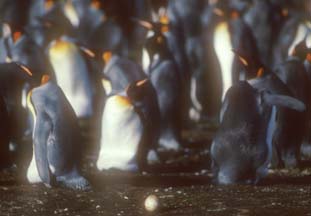 There were a few abandoned eggs lying on the
bare earth. Once a penguin drops its egg, it usually cannot get
it back up on its feet.
There were a few abandoned eggs lying on the
bare earth. Once a penguin drops its egg, it usually cannot get
it back up on its feet.
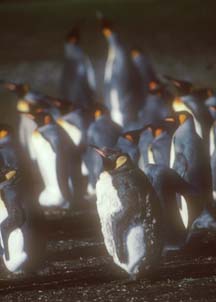 Some of the youngest penguins were still
molting, losing their downy coat in clumps.
Some of the youngest penguins were still
molting, losing their downy coat in clumps.
Many of the adult penguins were brooding eggs. Each held its large brown-spotted egg on its feet, covered by a large flap of belly skin and feathers. Occasionally a brooding adult would rise slightly, revealing the egg under its belly.
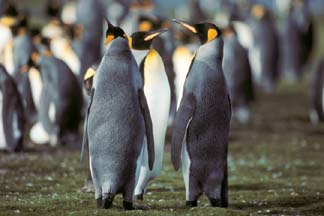 Penguins that had not yet found a mate were hanging around the
edges of the colony, standing in small groups.
Penguins that had not yet found a mate were hanging around the
edges of the colony, standing in small groups.
 They made frequent mating displays, pointing their beak straight
up, flapping their outstretched wings, and belting out their
penguin song.
They made frequent mating displays, pointing their beak straight
up, flapping their outstretched wings, and belting out their
penguin song.
Other unattached males would frequently join in the raucous display, leading to a chorus of loud calling by groups of a half-dozen or more. The chorus of mating calls was nearly continuous.
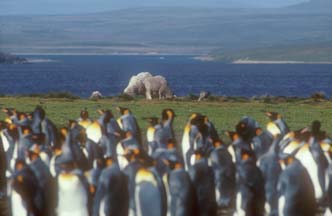 Sheep were grazing just a few yards
from the penguin rookeries.
Sheep were grazing just a few yards
from the penguin rookeries.
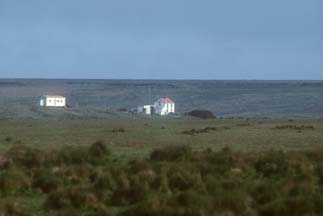 The
buildings of a sheep ranch were visible about a mile away.
The
buildings of a sheep ranch were visible about a mile away.
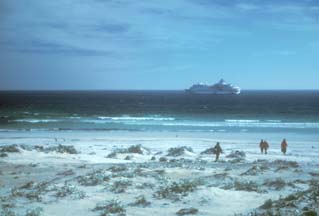 We returned
to the beach and watched the penguins heading out into the surf.
They waddling along in uncertain appearing groups, frequently
stopping and milling about, as if to check each other's opinion
of the wisdom of proceeding into the water. Once they reached the
edge of the water, they flopped down on their bellies and pedaled
forward into the approaching waves. When a wave washed over them,
they suddenly rocketed forward into the deeper water. They could
be seen flying through the water in the waves farther out.
We returned
to the beach and watched the penguins heading out into the surf.
They waddling along in uncertain appearing groups, frequently
stopping and milling about, as if to check each other's opinion
of the wisdom of proceeding into the water. Once they reached the
edge of the water, they flopped down on their bellies and pedaled
forward into the approaching waves. When a wave washed over them,
they suddenly rocketed forward into the deeper water. They could
be seen flying through the water in the waves farther out.
We donned our life jackets and climbed into a departing Zodiac. A series of three small waves broke over our bow as the driver maneuvered out of the surf zone. The metal bottom of the Zodiac was creaking, making a sound like an aluminum can makes as it is crushed. It was noted that we probably would not have gotten to land at Volunteer Point if the conditions had been as choppy when we arrived as they were when we departed.
 Table of
Contents
Table of
Contents You can buy a 2020 Calendar featuring my photographs of Antarctic Landscapes.
A dozen photos of Antarctic Landscapes. Locations include:
Cape Wild and Cape Lookout on Elephant Island,
Paulet Island,
the Weddell Sea,
Neko Harbor in Andvord Bay on the Antarctic Peninsula, and
Deception Island.
 Put a copy of the Antarctic Landscapes 2020 Calendar in your Lulu.com shopping cart for $14.95.
Put a copy of the Antarctic Landscapes 2020 Calendar in your Lulu.com shopping cart for $14.95.
You can buy a 2020 Calendar featuring my photographs of seals taken in Antarctica.
A dozen photos of seals in Antarctica. Seals pictured include:
Antarctic Fur
Weddel
Crabeater
Southern Elephant.
Locations include:
Cape Lookout on Elephant Island
Deception island
Livingstone Island
Antarctic Sound.
 Put a copy of the Antarctic Seals 2020 Calendar in your Lulu.com shopping cart for $14.95.
Put a copy of the Antarctic Seals 2020 Calendar in your Lulu.com shopping cart for $14.95.
You can buy a 2020 Calendar featuring my photographs of birds taken in the Falkland Islands and the South Shetland Islands in Antarctica.
A dozen photos of birds taken in the Falkland Islands South Shetland Islands in Antarctica. Birds pictured include:
Southern Giant Petrel
Black Browed Albatross
Falklands Skua
Blue-Eyed Shag (King Cormorant)
Black Crowned Night Heron
Patagonia Duck
Pied Oystercatcher
Snowy Sheathbill
Cape Petrel
Kelp Gull.
 Put a copy of the Birds of the South Atlantic and Antarctica 2020 Calendar in your Lulu.com shopping cart for $14.95.
Put a copy of the Birds of the South Atlantic and Antarctica 2020 Calendar in your Lulu.com shopping cart for $14.95.
You can buy a 2020 Calendar featuring my photographs of penguins taken in Antarctica and the Falkland Islands.
A dozen pictures of penguins taken in Antarctica and the Falkland Islands. Penguin species pictured include:
Gentoo
Adele
Chinstrap
Rockhopper
Macaroni
Magellanic
King.
Locations where the photographs were taken in the Falkland Islands include:
New Island
Carcass Island
Volunteer Point.
Antarctic locations include:
Paulet Island
Cape Lookout on Elephant Island.
 Put a copy of the Penguins 2020 Calendar in your Lulu.com shopping cart for $14.95.
Put a copy of the Penguins 2020 Calendar in your Lulu.com shopping cart for $14.95.
 Send
a message to Brian.
Send
a message to Brian.